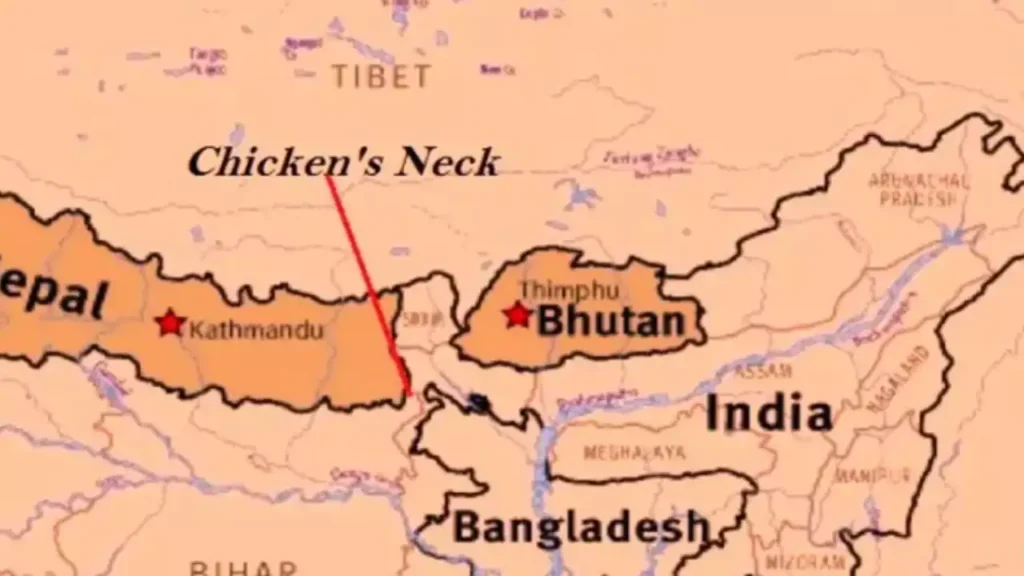India’s ‘Chicken Neck’: The Siliguri Corridor and Its Critical Role in National Security and Connectivity


The Siliguri Corridor, often referred to as India’s “Chicken Neck,” is a narrow yet vital stretch of land that plays a crucial role in linking mainland India with its northeastern states. Spanning just about 22 kilometers in width and 60 kilometers in length, this strategic strip of territory is bordered by Nepal on the west, Bhutan on the east, and Bangladesh to the south. Despite its size, the corridor holds immense geopolitical, economic, and strategic value for the nation.
The corridor’s geography places it at the heart of regional geopolitics. Located close to the tri-junction of India, China, and Bhutan near Doklam, it serves as the only overland route connecting India’s northeastern region to the rest of the country. Surrounded by three foreign nations, any disruption or blockade could significantly affect connectivity and security. This makes the Siliguri Corridor a focal point in India’s defense and foreign policy.
Economically, the corridor facilitates the transportation of goods, services, and resources between northeastern states and other parts of India. It is especially crucial for the movement of commodities such as tea from Assam and timber from the region’s dense forests. Moreover, it serves as a strategic gateway for cross-border trade with Nepal, Bhutan, and Bangladesh, enhancing India’s economic ties with its neighbors and boosting regional integration.
Recognizing the corridor’s critical importance, the Indian government has been investing in major infrastructure projects aimed at strengthening both connectivity and security. These include the development of alternate railway and road routes through Bangladesh to reduce dependence on the narrow corridor. Enhanced infrastructure will not only ease logistics but also ensure faster military mobilization in times of need.
The corridor’s narrow width and its location at the convergence of multiple borders make it highly vulnerable from a national security perspective. Experts have long warned that any conflict or diplomatic standoff with neighboring countries could threaten this vital link. India’s military strategists view the corridor as a high-priority area, necessitating constant vigilance and robust defense planning.
In response to growing infrastructure needs, several projects are underway to upgrade transport and logistics in the region. One key concern has been the structural decline of the historic Coronation Bridge over the Teesta River, a vital component of the corridor. Plans for its urgent repair and possible replacement underscore the government’s focus on maintaining uninterrupted connectivity.
Given the corridor’s location, cooperation with neighboring countries like Bangladesh, Nepal, and Bhutan is essential. The success of proposed rail links through Bangladesh and trade agreements with these countries reflects India’s diplomatic efforts to ensure regional stability and secure its strategic interests.
From a defense perspective, the Siliguri Corridor is irreplaceable. It acts as the sole supply and transit route for troops and equipment heading to India’s northeastern frontiers, including sensitive areas near the China border. In the event of military escalation or conflict, the corridor’s security becomes paramount to sustaining operations and maintaining territorial integrity.
Beyond its strategic and economic importance, the Siliguri region is also rich in biodiversity and cultural diversity. It is home to numerous communities and ethnic groups that contribute to India’s rich cultural mosaic. The surrounding forests and rivers also form part of a critical ecological zone, which requires thoughtful development to preserve its natural beauty and environmental value.
As India strengthens its presence in the Indo-Pacific and enhances northeastern connectivity, the Siliguri Corridor will remain central to both policy and planning. Balancing infrastructure growth with ecological preservation, ensuring national security, and fostering good neighborly relations will define the future of this vital region.
In conclusion, the Siliguri Corridor—India’s “Chicken Neck”—is not merely a geographic choke point, but a strategic, economic, and cultural artery. Safeguarding and enhancing this corridor will be key to ensuring a secure and connected future for northeastern India.
For More News Updates – https://khabarsearch.in/